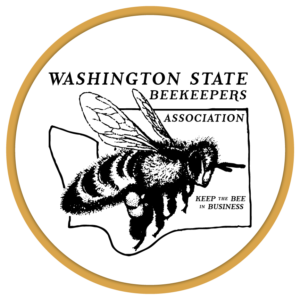Menu
Beekeepers Field Test
Practical Field Test Requirements:
The Washington State Beekeepers Association (WASBA) has developed and approved a practical field test. Part of the Field Test will include a walk-through demonstration of what will be covered during the practical field exam. The demonstration will be provided by the person evaluating the student. Students will receive a copy of the Journeyman Field Test Report for the practical Field Test prior to their evaluation. The Field Test will be conducted in the candidate’s apiary if possible.
Successful completion of the Field Test is required for Journeyman level students.
The following elements will be evaluated:
- General apiary appearance
- Hive appearance – organization
- General colony management
- Hive manipulation expertise
- Colony temperament
- Colony strength, adjusted for Nuc vs. parent colony and time of year
- Apiary sanitation and cleanliness
- Medication program – preventative
- Knowledge of environmental factors
- Public relations awareness
Practical Field Test Evaluation Categories:
- General Apiary Appearance
- Cleanliness
- Colony entrance accessibility
- Stored equipment – bee tight
- Equipment stored neatly
- Grass cut for fire protection
- Colonies spaced for bee drift control and ease of working
- Hive stands in good repair
- Air drainage planning
- Apiary complies with all local ordinances
- Hive Appearance – Organization
- Hive parts stacked properly and neatly
- Equipment painted adequately
- Adequate ventilation
- Hives tipped forward slightly
- Apiary obscured from view
- General Colony Management
- Organization of the brood nest
- Too much drone comb
- Placement of the brood nest in the hive
- Location and amount of pollen
- Amount of honey stores
- Feeding program
- Supering expertise – adjusted for time of year and area
- Knowledge of nectar flows – average production
- Swarm prevention techniques
- Re-queening procedure
- Two queen colonies
- Manipulation Expertise
- Proper use of smoker
- Confidence in hive manipulation
- Gentle but predictable movements
- Avoid quick or jerky manipulations
- Have smoker available at all times
- Place hive parts close at hand
- Proper lifting techniques
- Place smoker safely on ground – reduce fire hazard
- Age of comb
- Comb rotation practices and knowledge
- Proper use of queen excluder. Use of other equipment – pollen traps, etc.
- Careful handling of comb to prevent loss or damage of queens
- Colony Temperament
- Knowledge of colony noises – queenless, other
- Cluster density
- Cluster activity – running or quiet on the comb
- Guard activity – quiet or vicious
- What activities affect temperament?
- Colony strength – Adjusted – Nuc vs. Parent, Time of Year
- Minimum Nuc size
- Pollination standards
- Planning for the honey flow
- Hive reduction for wintering – considerations, use of queen excluder
- Effect of temperature on cluster
- How to measure colony strength
- Sanitation and Cleanliness
- Proper disposal of comb scrapings
- Hive tools cleaned regularly
- Proper disposal of smoker fuel residue, miticides
- General apiary appearance
- Medication Program – Preventative
- Knowledge of various programs
- Are procedures adequate?
- Is timing adequate?
- Knowledge of Environmental Factors
- Effect of temperature on bee flight
- Effect of wind on cluster behavior and management
- Agricultural chemical effect on colonies
- Air drainage and movement
- Effect of transportation on colonies
- Effect of daylight on bee flight
- Public Relations Awareness
- Applicable local ordinances
- Water accessibility
- Knowledge of other insects confused with bees
- Knowledge of local and state industry leaders
- Consideration of neighbors – public nuisance factors
